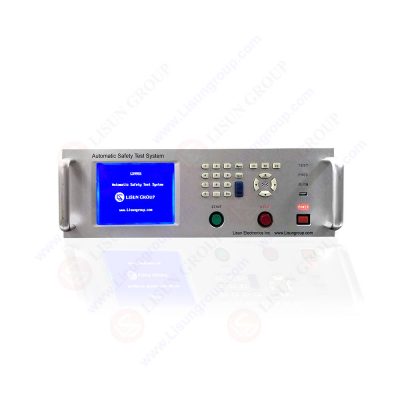With the rapid development of contemporary science and technology, measuring instruments for electrical safety performance, various electrical appliances and electronic equipment have entered all fields of social life, becoming an important symbol of the progress of social civilization.
Electrical safety performance test mainly includes withstand voltage test, insulation resistance test, leakage current test and grounding resistance test. All kinds of electrical appliances and electronic equipment are rapidly popularized in urban and rural areas across the country, bringing great convenience to production.
However, the widespread use of various electrical and electronic equipment has resulted in a great increase in personal accidents. Hazards to life and property, electric shock injuries and electrical fires are common examples. Therefore, the important issue of the use safety of electrical appliances and electronic equipment has become the most important factor in determining product quality, and safety standards have become one of the most important technical standards.

electronic equipment
Earth Resistance Test:
Grounding resistance test, also known as grounding continuity test, grounding test must be carried out for all Class I products. The purpose of the test is to ensure that all conductive parts on the product will become live in the event of a single insulation failure, and that the conductive parts that can be touched by the user are reliably connected to the grounding point of the power input. In other words, a ground test uses a high current, low voltage source to the ground return to verify the integrity of the ground path.
Compliance with the standard is judged by measuring the impedance connected between the protective earth connection terminal or the earth contact and the part. Impedances that do not exceed a certain value determined by the product safety standard are considered compliant.
After measuring the grounding resistance, we can judge whether the grounding resistance is within a reasonable range according to this value, so as to achieve the effect of protecting the grounding device. If the grounding resistance is required when installing electrical equipment, the accident of electric shock can be prevented. Because some electrical enclosures are made of metal, after a long time of use, it will inevitably be damaged, resulting in the destruction of the insulator. In order to avoid electric shock accidents, grounding resistance is required. It can also prevent static grounding, because some electronic equipment or natural gas will have the effect of static electricity. If a grounding resistance is connected, it can prevent the danger caused by static electricity. It can also achieve the effect of lightning protection. In the season of thunderstorms, the destructive power is still very large. In order to prevent the damage of lightning, it is necessary to connect the grounding resistance when the lightning is introduced into the ground. For example, some buildings will install lightning rods to test the resistance of the lamp shell and the ground wire to detect whether the ground wire is effective. Under the 10A test current, the shell resistance with the ground wire does not exceed 500mΩ time: at least 1s.
Withstand voltage test:
Withstand voltage test is one of the main methods to test the ability of electrical appliances, electrical equipment, electrical installations, electrical circuits and electrical safety appliances to withstand overvoltage.
The withstand voltage test, also known as the dielectric strength test, also known as the hipot test, is probably the most well-known and frequently performed production line safety test. In fact, showing its importance is part of every criterion. The hipot test is a non-destructive test to determine that electrical insulating materials are sufficiently resistant to transient high voltages. This is a high voltage test that applies to all equipment to ensure that the insulation is adequate. Other reasons to perform the hipot test is that it can detect possible defects such as insufficient creepage distances and clearances caused during the manufacturing process.
There are two kinds of withstand voltage tests: power frequency withstand voltage test and DC withstand voltage test.
Power frequency withstand voltage test:
The test voltage of the power frequency withstand voltage test is more than one to several times the rated voltage of the equipment under test, not less than 1000V. The pressurization time: 1 minute for equipment with porcelain and liquid as the main insulation, 5 minutes for equipment with organic solids as the main insulation, 3 minutes for voltage transformers, and 10 minutes for oil-immersed power cables. Electrical equipment can find local defects, moisture and aging of insulation through withstand voltage test.
AC withstand voltage test:
The AC withstand voltage test is carried out at 2.5 times and above the voltage of the device under test. From the viewpoint of thermal breakdown of dielectric loss, it can effectively find local free defects and weak points of insulation aging. Since the voltage is mainly divided by the capacitor under the alternating voltage, the insulation defects of the equipment can be effectively exposed.
It mainly achieves the following purposes:
• Ability to detect insulation withstand voltage by working voltage or overvoltage;
• Check the quality of electrical equipment insulation manufacturing or maintenance;
• Eliminate damage to insulation caused by raw materials, processing or transportation, and reduce the early failure rate of products;
• Check insulation clearances and creepage distances.
• Test the insulation between the energized input part of the luminaire and the non-energized metal enclosure (heat sink) part under high voltage conditions. The better the insulation performance, the lower the leakage current. Time: at least 1s
• Class I lamps (with ground wire): high voltage 1750v, leakage current not exceeding 5ma
• Class II lamps (without ground wire): 3750v, the leakage current does not exceed 5ma
(According to the test requirements of the new GB7000.1-2015 standard [see the figure below]) Class I and Class II lamps both use 1500v, and the leakage current does not exceed 5ma)
Leakage current (touch current, the smaller the better)
Leakage current refers to the current formed by the surrounding medium or insulating surface between electrically insulated metal parts, or between live parts and grounded parts, under the condition of no fault applied voltage.
Non-conductive is just relative. There is virtually no insulating material that is absolutely non-conductive as ambient conditions change. For any insulating material, when a voltage is applied across it, a certain current will always flow through. The active component of this current is called, and this phenomenon is called leakage of the insulator.
Leakage current is actually the current flowing through the insulating part of an electrical line or device without faults and applied voltage. Therefore, it is one of the important signs to measure the insulation quality of electrical appliances, and it is the main indicator of product safety performance. Limiting leakage current to a small value plays an important role in improving product safety performance.
In electrical products, products with higher safety performance requirements have strict requirements on leakage current. There are clear regulations in the special requirements for many types of household electrical products: in the type test, if the leakage current test fails, it is regarded as a fatal defect, and retesting is not allowed; in the factory test of enterprise products, many electrical products, Leakage current testing is a must-check item. Therefore, the leakage current must be limited to a small value, which plays an important role in improving the safety performance of the product.
The leakage current that may be generated between each pole (L, N) of the power supply and the metal shell when the lamp works under the normal rated voltage. Usually more than 1ma of current flowing through the human body may cause electric shock, and the size of the electric shock is related to body weight. Time: at least 1s
• Class 1 lamps (with ground wire): no more than 1ma
• Class II lamps (without ground wire): 0.5ma (according to the test requirements of the new GB7000.1-2015 standard)
Insulation resistance (the higher the resistance, the better)
By measuring the insulation resistance of electrical equipment, the following purposes can be achieved:
• Understand the insulating properties of insulating structures. A reasonable insulating structure (or an insulating system) composed of high-quality insulating materials should have good insulating properties and high insulation resistance;
• Understand the quality of insulation treatment of electrical products. If the insulation treatment of electrical products is not good, the insulation performance will be significantly reduced;
• Understand the dampness and pollution of the insulation. When the insulation of electrical equipment is damp and polluted, its insulation resistance usually drops significantly;
• Verify that the insulation withstands the withstand voltage test. If the withstand voltage test is performed when the insulation resistance of the electrical equipment is lower than a certain limit, a large test current will be generated, resulting in thermal breakdown and damage to the insulation of the electrical equipment. Therefore, various test standards usually stipulate that the insulation resistance should be measured before the withstand voltage test.
• After applying 500v DC voltage for 1min, the insulation resistance between the live part of the lamp (input L, N) and the non-charged metal parts
• Class II: 500V not less than 2MΩ (old standard in 2007: not less than 4MΩ)
• Class I: 500V not less than 2MΩ (old standard in 2007: not less than 2MΩ).


LS9955_Automatic Safety Test System
Our main products are Goniophotometer, Integrating Sphere, Spectroradiometer, Surge Generator, ESD Simulator Guns, EMI Receiver, EMC Test Equipment, Electrical Safety Tester, Environmental Chamber, Temperature Chamber, Climate Chamber, Thermal Chamber, Salt Spray Test, Dust Test Chamber, Waterproof Test, RoHS Test (EDXRF), Glow Wire Test and Needle Flame Test.
Please feel free to contact us if you need any support.
Tech Dep: Service@Lisungroup.com, Cell/WhatsApp:+8615317907381
Sales Dep: Sales@Lisungroup.com, Cell/WhatsApp:+8618117273997
Your email address will not be published. Required fields are marked *